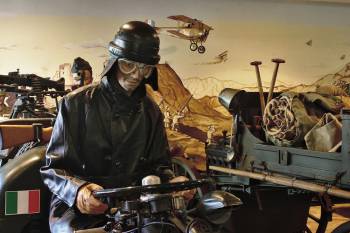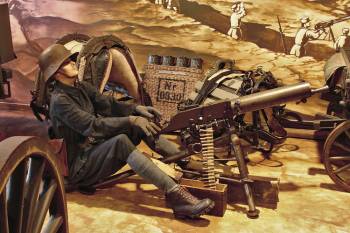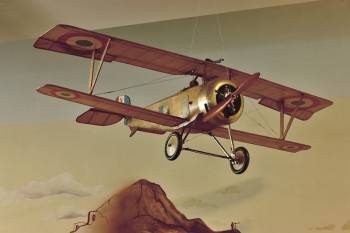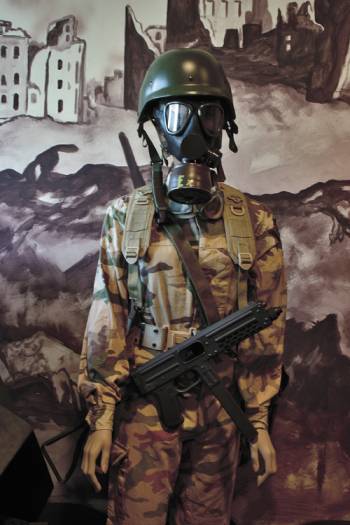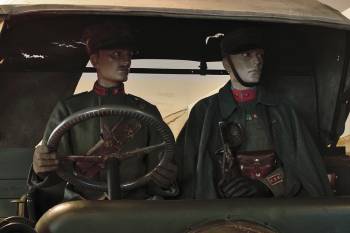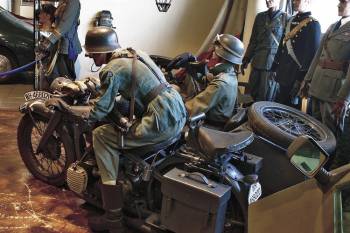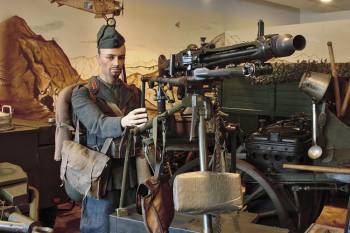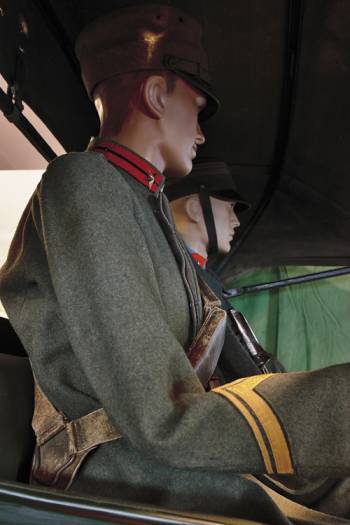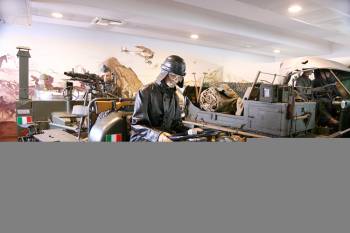Military area
First World War
The First World War starter because the Archduke of Austria Francesco Ferdinando of Hapsburg was killed in Sarajevo on 28 June 1914 by the irredentist Serbian student Gavrilo Princip.
In a short while due to the various alliances among European countries: the Austro-Hungarian Empire, Germany and Turkey on one side, Russia, France, England, followed by Italy, Japan and the USA on the other, nearly all of Europe was involved: from the Urals to the Pyreneans, from the North Sea to the African Sea.
All the lands of the British Commonwealth also entered the war: meaning that it could truly be called the First World War.
The Europe that took part in that crazy enterprise was characterised by countries with varying levels of technological progress: backward, mainly peasant Russia, against Germany and England where heavy industry and steel in particular already lead the economy of the continent.
France, followed by Italy, were on lower industrialisation levels, where the geographic and social articulation, division between an economically developing north and a backward slow south, gave the image of a “two-speed” country.
Beyond the oceans, the USA and Japan already represented new economic poles and political influence. Japan had surprised the world by beating Russia in 1905 in the Manchurian war, the first where a modern war fleet was used, that of Japan, and on the battlefields airplanes and machine guns were used.
The USA had never been measured in a war by the Europeans, except for the Cuba war against Spain, but it was no surprise when the American Giant could have made the difference once it entered the field, as it did in 1917. The Pittsburgh steelworks and mechanical industry took giant steps forward: Henry Ford already represented a lesson for the entire industrialised world.
This was the scene when the armies entered battle and brought all the technology and industry with them, at the turn of the century between 1800 and 1900, in military form onto the battlefields.
The trenches, skies and seas became places of technological experimentation, terrifying laboratories where all types of offensive and defensive instruments were tested.
Airplanes that had already been used in the Libyan war in 1911 were increasingly used in all the battle areas, first as observers and reconnaissance, then as bombers.
Increasingly powerful artillery sowed death and destruction in all the battles; it is calculated that they caused 70% of deaths.
Several arms were invented during the First World War: for example among the barbed wire fences and trenches of the French Front, for example the light tanks appeared, a terrible arm that is still widely used to day in the modern version by all the armies in the world.
Machine guns and flame throwers added even more horror to the desperate conditions of the soldiers of all the armies involved, like the gases which were often used by all and were so horrifying that it was internationally agreed that they should never be used again in any future wars.
The Second World War
The Second World War was caused by a serious of political and military actions that Germany, governed since 1933 by the national-socialist party, used to attack the confining countries that Germany had certain pretexts to.
From the forced attachment of Austria in 1935, of Sudetenland in 1938, through to the claims of the land and town of Danzig, in Eastern Prussia, but at the end of the First World War surrounded by Polish territory and isolated from Germany, when the Second World War broke out, Europe -1st September 1939.
In 1939 – faced history with a much different appearance to that of 25 years earlier when the First World War broke out.
On the European scene it was no longer the Monarchies that monopolised attention, but dictatorships: the first being the fascist regime in Italy with the rise to power of Benito Mussolini in 1923, followed by the national-socialist era that took Adolf Hitler to power in 1933, not to forget Spain led by Francisco Franco, who took over, actively supported by the Italian and German dictators after a bloody Civil War.
To the East, the revolution in 1917 led Russia out of the First World War, but had generated the Soviet Dictatorship of Josip Stalin. German and Italian dictatorships were busy on two fronts: internally strengthening their power, developing industry and technological poles, externally with expansionist politics, mainly of European inspiration to gain new territories for the nation of Germany, more colonial the expansionism of Italy.
England and France were basically isolated and afraid of Germany that was quickly being rearmed and by Russia, which was far from friendly towards Western politics, and was neither a bulwark nor a deterrent to the expansionist policies of Germany, added to the strongly isolationist attitude of the USA which concentrated on monitoring the expansionism of Japan to the East and to consolidate its markets and trade, after the disastrous crisis in 1929.
It was in this context of events that Hitler’s decision matured to declare war on Poland, and, for the structure of the alliances, automatically, with France and England, the Second World War started.
In the Second World War besides the so-called white arms, by now something of the past, there was very fierce technological competition, for the first time the power of a nation was no longer determined by the number of soldiers it managed to enrol but by its technological and energy resources: steel, aluminium, oil, foundries and mechanical industries.
German power at the beginning and throughout most of the war is a clear example, which was soon reached and overtaken by the amazing recovery of the USA. In a few years the wooden planes became entirely metal, they were loaded on fast ships and fitted with jet engines.
Instruments like “Honeycomb” radiator section. often changed the results of a battle, while all types of vehicles, tracked and other, ran through the countryside of Europe and Asia. Arms were increasingly powerful and terrible until the atomic bomb was invented, the “ultimate weapon, desired by the Germans and Americans throughout the final phase of the war.
Some of the examples on show
- FIAT 18P tank – Italy – 1907 – used on the Italian front during the First World War .
- Camp kitchen – 1960 – using kerosene, used by the Italian arm and the NATO forces up until the 90s. With bread oven, it was also used for civil defence.
- Towing truck – 1915 – Used for logistics transport and for the Red Cross.
- Plane Nieuport 11 “Bebè” (model) – France used during the First World War.
- Mechanic mule – Italy – 1960-1963 – Variable pitch tracked vehicle, type S.T.M.E. Moto Guzzi 3×3. Examples made: 423
- Camp kitchen – Italy 1907-1909 – Used by the Italian Army during the First World War. At the end of the war it was given to the Swiss Red Cross.
- Pedal generator – Germany – 1950-1960 – Made by Telefunken for the NATO forces.
- Armoured car F333E – Italy – 1970 – Prototype made in a single model by Ferrari Engineering in Turin. Armoured car on wheels for numerous uses, reconnaissance, observation, fast patrolling and support for arms and/or electronic equipment.
- Mule packs – Italy – Used by the Alpine troops during the First World War, they had two functions: one carried the chattels and rations; the other had metal rods and carried small mountain artillery.
- Amphibious FN Tricar AS24 made for the Belgian and French troops. Recently used by Belgian paras in the military operations in the ex-Belgian Congo in 1960.
- Motor-tank BMW R12 – Germany – 1948 – this model, with MG42 travelling machine gun, was used by Oberkommander der 9° Panzer Division.
